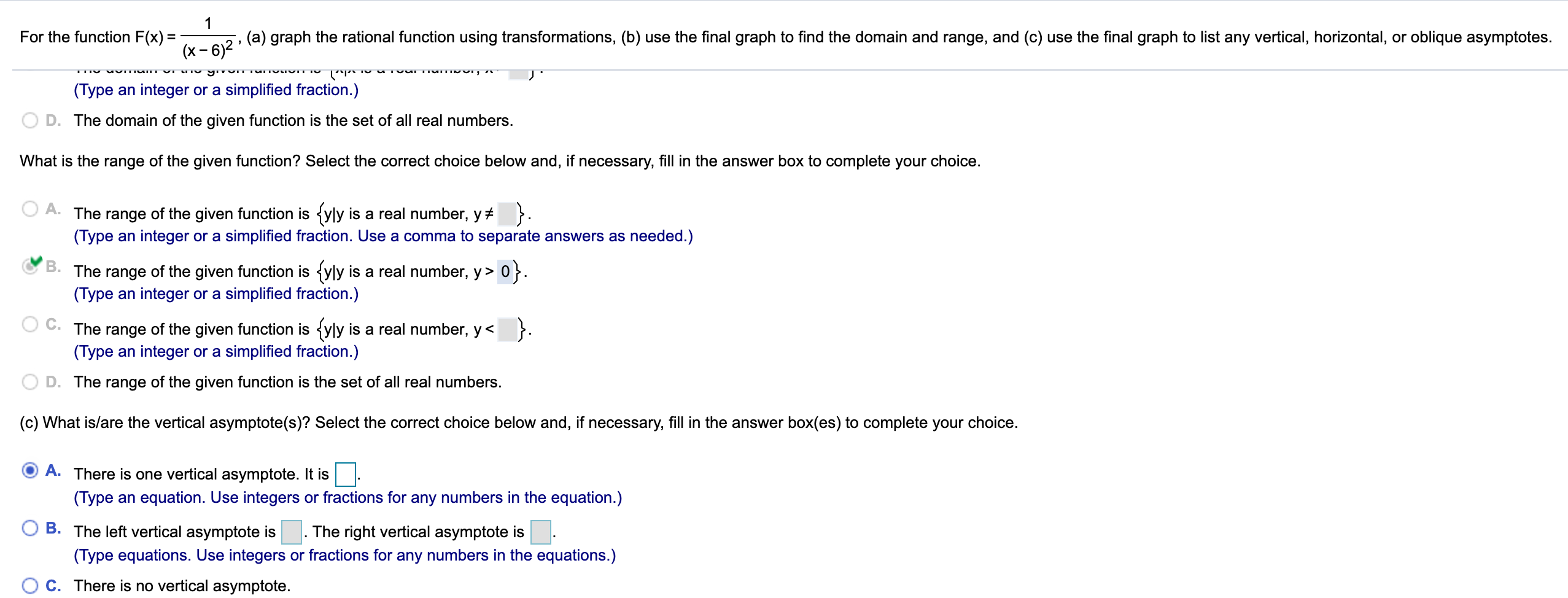For the function F(x) = (x – 6)2 (a) graph the rational function using transformations, (b) use the final graph to find the domain and range, and (c) use the final graph to list any vertical, horizontal, or oblique asymptotes. (Type an integer or a simplified fraction.) D. The domain of the given function is the set of all real numbers. What is the range of the given function? Select the correct choice below and, if necessary, fill in the answer box to complete your choice. A. The range of the given function is {yly is a real number, y+ }. (Type an integer or a simplified fraction. Use a comma to separate answers as needed.) B. The range of the given function is {yly is a real number, y> 0}. (Type an integer or a simplified fraction.) The range of the given function is {yly is a real number, y< }. (Type an integer or a simplified fraction.) D. The range of the given function is the set of all real numbers. (c) What is/are the vertical asymptote(s)? Select the correct choice below and, if necessary, fill in the answer box(es) to complete your choice. A. There is one vertical asymptote. It is (Type an equation. Use integers or fractions for any numbers in the equation.) B. The left vertical asymptote is (Type equations. Use integers or fractions for any numbers in the equations.) C. There is no vertical asymptote. The right vertical asymptote is.
For the function F(x) = (x – 6)2 (a) graph the rational function using transformations, (b) use the final graph to find the domain and range, and (c) use the final graph to list any vertical, horizontal, or oblique asymptotes. (Type an integer or a simplified fraction.) D. The domain of the given function is the set of all real numbers. What is the range of the given function? Select the correct choice below and, if necessary, fill in the answer box to complete your choice. A. The range of the given function is {yly is a real number, y+ }. (Type an integer or a simplified fraction. Use a comma to separate answers as needed.) B. The range of the given function is {yly is a real number, y> 0}. (Type an integer or a simplified fraction.) The range of the given function is {yly is a real number, y< }. (Type an integer or a simplified fraction.) D. The range of the given function is the set of all real numbers. (c) What is/are the vertical asymptote(s)? Select the correct choice below and, if necessary, fill in the answer box(es) to complete your choice. A. There is one vertical asymptote. It is (Type an equation. Use integers or fractions for any numbers in the equation.) B. The left vertical asymptote is (Type equations. Use integers or fractions for any numbers in the equations.) C. There is no vertical asymptote. The right vertical asymptote is.
Chapter4: Rational Functions And Conics
Section: Chapter Questions
Problem 25RE
Related questions
Question

Transcribed Image Text:For the function F(x) =
(x – 6)2
(a) graph the rational function using transformations, (b) use the final graph to find the domain and range, and (c) use the final graph to list any vertical, horizontal, or oblique asymptotes.
(Type an integer or a simplified fraction.)
D. The domain of the given function is the set of all real numbers.
What is the range of the given function? Select the correct choice below and, if necessary, fill in the answer box to complete your choice.
A.
The range of the given function is {yly is a real number, y+ }.
(Type an integer or a simplified fraction. Use a comma to separate answers as needed.)
B.
The range of the given function is {yly is a real number, y> 0}.
(Type an integer or a simplified fraction.)
The range of the given function is {yly is a real number, y< }.
(Type an integer or a simplified fraction.)
D. The range of the given function is the set of all real numbers.
(c) What is/are the vertical asymptote(s)? Select the correct choice below and, if necessary, fill in the answer box(es) to complete your choice.
A. There is one vertical asymptote. It is
(Type an equation. Use integers or fractions for any numbers in the equation.)
B. The left vertical asymptote is
(Type equations. Use integers or fractions for any numbers in the equations.)
C. There is no vertical asymptote.
The right vertical asymptote is.
Expert Solution
This question has been solved!
Explore an expertly crafted, step-by-step solution for a thorough understanding of key concepts.
This is a popular solution!
Trending now
This is a popular solution!
Step by step
Solved in 3 steps

Recommended textbooks for you


College Algebra
Algebra
ISBN:
9781305115545
Author:
James Stewart, Lothar Redlin, Saleem Watson
Publisher:
Cengage Learning

College Algebra (MindTap Course List)
Algebra
ISBN:
9781305652231
Author:
R. David Gustafson, Jeff Hughes
Publisher:
Cengage Learning


College Algebra
Algebra
ISBN:
9781305115545
Author:
James Stewart, Lothar Redlin, Saleem Watson
Publisher:
Cengage Learning

College Algebra (MindTap Course List)
Algebra
ISBN:
9781305652231
Author:
R. David Gustafson, Jeff Hughes
Publisher:
Cengage Learning

Algebra for College Students
Algebra
ISBN:
9781285195780
Author:
Jerome E. Kaufmann, Karen L. Schwitters
Publisher:
Cengage Learning

Algebra and Trigonometry (MindTap Course List)
Algebra
ISBN:
9781305071742
Author:
James Stewart, Lothar Redlin, Saleem Watson
Publisher:
Cengage Learning
